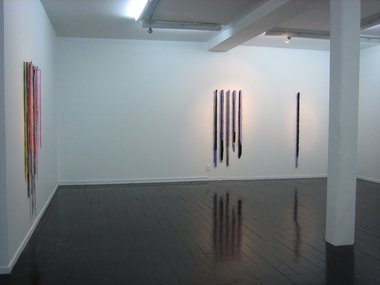John Hurrell – 20 September, 2011
The coloured strips push and pull laterally within different horizontal pressures, while the different lengths squeezed together make vertical tensions to be seen from the front. The hue balance shifts as you walk around and view from the side - getting glimpses of the inner wrinkled strips perceived only around their edges.
This exhibition is of Helen Calder’s coloured paint skins, vertically hung strips of dried and rubbery housepaint emulsion, stacked over each other in small groups and suspended from a thick metal pin at the top. The length of each curly scallopped paint varies, having oddly arabesqued contours and bubbly vertical striations. This causes strips of colour at the back peep through to the front, and to give the lines considerable thickness.
If hung in same-colour groupings to gain extra physical chromatic depth - and carefully spaced apart - these vertical sculptural forms with their wobbly curvy edges look vaguely like unfurled saturated lines from early sixties Washington painter Morris Louis’ innovative stained works (his ‘corner’ paintings particularly - though the paint & surface quality is quite different).
Despite the complexity of contour, the white gallery walls become negative spaces and take on the illusory role of unpainted canvas. This means that the coloured strips push and pull laterally within different horizontal pressures, while the different lengths squeezed together make vertical tensions to be seen from the front. The hue balance shifts as you walk around and view from the side - getting glimpses of the inner wrinkled strips perceived only around their edges.
The best ones in my view are those closest to traditional painting in that they have a horizontal spread like that of a landscape format. They consist of several relief lines spaced in a row. Not the singles - those solo clusters for me lack impact, lack muscle, and perhaps are too long anyway. They can’t sustain intensity.
In this show I think Calder might have over complicated her compositional ideas. Many of the works are (I think) a bit fiddly with too many colours and tones. A more limited chromatic range would be more effective so that the sculptural form of her method is emphasised (indeed, more thoroughly exploited) instead of being perceptually fragmented.
What is interesting about Calder’s practice is that like say Rohan Wealleans she is using paint as a substance from which to create sculpture, pushing out from the wall. The material has properties she keeps discovering that take it far beyond its original purpose, with added tongue and hidelike, vegetable peeling associations. Rich in possibilities for the future.
John Hurrell









 Advertising in this column
Advertising in this column Two Rooms presents a program of residencies and projects
Two Rooms presents a program of residencies and projects



This Discussion has 0 comments.
Comment
Participate
Register to Participate.
Sign in
Sign in to an existing account.